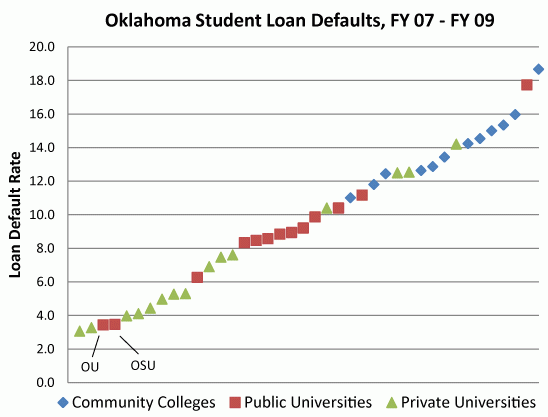[UPDATE: A previous version of the debt-to-degree chart misidentified Northwestern Oklahoma State University as a community college when it is a four-year university. The corrected chart reflects that NWOSU has the lowest debt to degree ratio among Oklahoma’s public universities.]
We’ve previously discussed the overwhelming evidence that college is a good investment both for students and the state as a whole. The need for at least some college education to get a good job is greater than ever. That’s reflected in Oklahoma by record-breaking college enrollment.
Lawmakers are also taking a growing interest in Oklahoma’s higher education system, with much of their criticism focused on tuition increases. A bill has already been introduced to return the power to approve tuition increases to the legislature, reversing a 2003 change that gave the State Regents full control.
Rising tuition is a legitimate concern. However, advertised tuition rates are not the best way to evaluate colleges and universities for a number of reasons. Due to scholarships and financial aid, fewer than half of all public university students and fewer than 18 percent of private college students pay the full “sticker price” for their education.
What may be a better metric for how well students are being served by a school are the federal loan default rates. The federal government made or guaranteed more than 80 percent of all outstanding student loans this year. If a large proportion of students are unable to pay back their loans, that is a strong indicator that they are not able to find well-paying jobs after leaving school, with or without a degree.
Oklahoma’s overall default rate was sixth highest in the nation at 10.77 percent, compared to a national average of 8.8 percent. However, as the below chart shows, default rates varied widely between schools.
 This shows the percentage of students at Oklahoma colleges and universities who defaulted on federal student loans between FY ‘07 and FY ’09. Schools are divided into three groups: public community colleges, public universities, and private universities.
This shows the percentage of students at Oklahoma colleges and universities who defaulted on federal student loans between FY ‘07 and FY ’09. Schools are divided into three groups: public community colleges, public universities, and private universities.
The data comes from the U.S. Department of Education. You can download specific numbers for Oklahoma schools as a spreadsheet here.
Students at public universities generally had higher default rates than those at private universities, but the best performing public universities were also the largest. Students at OU and OSU had loan default rates of just 3.4 percent and 3.5 percent, respectively. These two schools did better than all of other public and private colleges except for Southern Nazarene University, which posted a rate of 3.1 percent, and Oklahoma City University, with a default rate of 3.3 percent.
The best performing community college was Tulsa Community College, which posted a default rate of 11.0 percent, while the worst was Eastern Oklahoma State College, with a rate of 18.7 percent. The worst-performing private college was the the Spartan College of Aeronautics and Technology, with a default rate of 14.2 percent. Among public 4-year schools, Langston University performed especially poorly, with 17.7 percent of students defaulting on loans.
Community colleges in general fared worse than most public and private 4-year universities. However, we should keep in mind that community college students as a group are less economically secure than those attending 4-year schools, and even after graduating, they face a tougher job market in most fields than do applicants with bachelor’s degrees. Community colleges must also accept all applicants, while universities are able to selectively admit the students most likely to succeed.
Another way to look at the situation is the debt to degree ratio. Using data from Education Sector, this chart shows the the total amount of money borrowed by undergraduates at Oklahoma post-secondary schools divided by the total number of degrees awarded. [Click the chart to see a full-sized version.]
When we combine these measures, OU comes out looking like the best deal with both a very low student default rate and a relatively low debt to degree ratio. Carl Albert State College has a significantly lower debt to degree ratio than any other, yet has one of the worst loan default rates at 16.0 percent. Relative to other community colleges, TCC performs well on both measures.
In what may be a sign of serious trouble for particular schools, some fare badly on both measures. Langston University is the most obvious poorly-performing outlier in the public higher education system. Among private schools, Bacone College, the Spartan College of Aeronautics and Technology, and St. Gregory’s University share the dubious distinction of having both high default rates and a high debt to degree ratio.
Across different types of colleges, the debt to degree ratio is in some respects a mirror image of the student loan default rate. While community college students are most likely to default, these schools leave students with the least amount of debt per degree awarded. Conversely, most private university students have significantly higher debts but are less likely to default. If nothing else, this should tell us that keeping tuition low is no silver bullet for helping students to succeed.





 OKPOLICY.ORG
OKPOLICY.ORG





3 thoughts on “Beyond tuition: Better measures for the cost and value of higher education”